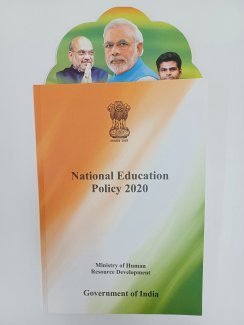Artikkelit

20.11.2024
Has Anything Changed? Education and Science Policy of the Modi 3.0 Government, Joel Hakala
In the Indian general election held from April to June this year, Prime Minister Narendra Modi’s Bharatiya Janata Party (BJP) surprisingly lost its absolute majority in the parliament, a position it had held since its rise to power in 2014. BJP was forced to form a coalition government with support from various regional parties. As the “Modi 3.0” government is looking to complete its first 6 months in power at the beginning of December, it is time to have a look at how the new parliamentary term in Indian politics looks from the perspective of education and science.
Even though the BJP had to form a coalition government, it has 26 ministers out of a total of 31, and Prime Minister Modi made only a few changes to his Council of Ministers. Among others, the Union Minister of Education, Dharmendra Pradhan, as well as the Minister of State for Science and Technology, Jitendra Singh, both remained in their positions from the previous Modi government. All the important ministers, such as Minister of Home Affairs, Minister of External Affairs, Minister of Defence, and Minister of Finance remained the same, indicating continuity.
The Modi 3.0 program also remains very similar from his previous two terms, mixing a high focus on economic development with a Hindu nationalist agenda. However, this time the Modi government has to listen to its coalition partners, and the empowered opposition has more muscles to criticize the government. There have already been a few incidents where the government has had to withdraw some of its initiatives due to opposition from BJP’s coalition partners. For example, in August a civil service recruitment program was withdrawn three days after its advertisement was published, as two of BJP’s coalition partners criticized it for not taking into account the caste reservations used in the Indian civil service recruitment.
When it comes to education, the Modi 3.0 government’s main initiative remains the National Education Policy (NEP), launched in 2020 during the second Modi government. Many of the targets of the NEP2020 were set for the year 2030, which means that during the next 4,5 years of the Modi 3.0, its implementation must be accelerated. For example, the target of 100% gross enrolment rate of all students from pre-primary to secondary by 2030, and the target of 50% enrolment in higher education by 2035, require increasing funding for education from the Modi government. In the first national budget presented by the new Modi government in July for the year 2024 –25, the federal spending on education remains at around 2.5 percent of the total spending, still very far from the 6 percent ambition set in the NEP2020.
During the past years, the NEP2020 has also faced criticism from many opposition-led states, especially in South India, but also from states such as Bihar where coalition member parties of the Modi 3.0 government are in power. The implementation of some aspects of the NEP2020 might become more difficult if the state-level opposition to it receives sympathy from some of BJP’s coalition partners.
However, when looking deeper into the government’s first budget, increasing spending was allocated especially on various initiatives focusing on skill development. One of the main themes of the 2024 general election was the high youth unemployment, and the opposition leaders did not hesitate to blame the ruling government for the situation during the election campaign. The Modi 3.0 government seems to be responding to the messages it received during the elections by creating new initiatives aiming to provide jobs for the youth. One example is the PM Internship Scheme launched in October, in which the government will fund internship opportunities for over 10 million young people in the next five years.
In the science and research sectors, the Modi government’s policy in the past 10 years has been characterized by large government-led initiatives officially aimed at reaching the target of “Viksit Bharat”, a developed India, by 2047 when the country celebrates 100 years of independence. National Quantum Mission, IndiaAI Mission, National Super Computing Mission, and Indian Space Vision 2047, initiated during the previous Modi governments, are some examples of them. The third Modi government has already launched similar new initiatives, such as the BioE3 Policy aiming to foster high performance biomanufacturing through R&D and entrepreneurship. Another initiative of the new government is the $119 million Space StartUps venture capital fund.
All in all, the Modi 3.0 government’s education and science policy seems to follow very much the same path as it took during the previous governments led by Modi since 2014, even if now the BJP has to keep its coalition partners satisfied to remain in power. However, more internal conflicts between the coalition partners could arise in the coming years – also on education policy, which is a sensitive topic in many parts of India.
Text: Joel Hakala, TFK Intern, New Delhi ((Liisa Toivonen)
Photo: Joel Hakala: The implementation of the National Education Policy 2020 continues to be an important task for the Modi 3.0 government.
